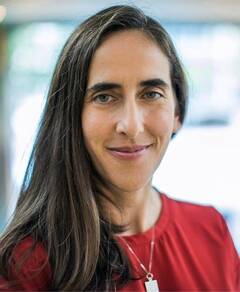Brotherhood Breakfast with Corrie Painter (ZOOM)
Sunday, November 14, 2021 • 10 Kislev 5782
9:15 AM - 11:15 AMZOOM "How surviving a rare and aggressive cancer propelled me on a life mission to accelerate cancer research"
"How surviving a rare and aggressive cancer propelled me on a life mission to accelerate cancer research"
Corrie Painter is a biomedical scientist at the Broad Institute of MIT and Harvard. As an eleven year survivor of a rare and aggressive cancer called angiosarcoma, she works at the interface of advocacy and genomics cancer research. She will be telling us about her experiences as a rare cancer survivor and how she launched a nation-wide study in her own cancer that led to discoveries that have been practice changing.
Check Star-Lite for the ZOOM link and password.
Her story:
I was lying in bed, about to fall asleep on an otherwise uneventful Friday night when I noticed a massive lump in my right breast. I couldn’t have known it at that moment, but this was the first of several turning points where my life became completely redefined. Everything was about to change.
It was February of 2010 and I was a few months away from defending my PhD thesis in biochemistry at the University of Massachusetts Medical School, and despite the differences between science at the atomic level and science in medicine, I knew enough to understand the literature around clinical presentations of breast cancer. My lump appeared within 2 weeks of a routine self breast exam, it moved freely in the tissue, and was not well circumscribed. These features weren’t consistent with what I had read about breast cancer tumors, so I thanked the internet and tried to put it out of my mind. What unfolded next was a diagnostic odyssey that included eight doctors on three medical teams at two institutions who ordered one fine needle aspiration, eleven core needle biopsies, MRI’s, CT’s, PET CT’s, mammograms, sonograms and a lumpectomy. All these tests yielded two misdiagnoses before getting a formal diagnosis of breast angiosarcoma. I got the final call while driving in a parking lot full of college students. I slammed on the brakes, threw the phone to my husband, climbed out of the van and collapsed in total despair. The next week I went back to my surgeon and had the rest of my breast as well as the underlying muscle removed in order to increase my chances of survival.
Angiosarcoma is an extremely rare and aggressive cancer derived from endothelial cells, which form the inner lining of blood vessels. There were only 300 people a year that were given this diagnosis in the US, and most of us would die within the first couple of years. I searched the scientific literature and found case reports and grim statistics, often noting that outcomes were ‘dismal’. There were a couple of retrospective studies that pooled data over decades from their institutions in order to analyze a handful of patients, but there was no real data. No data that someone trained as a scientist would bet their life on. The only thing I knew for sure was that this was bad, and I needed to prepare my 2 and 4 year old children for life without me.
It’s been 11 years since my diagnosis, and in that time, I launched a non-profit aimed at funding research and awareness, Angiosarcoma Awareness Inc, and I joined the Broad Institute of MIT and Harvard to launch a patient-partnered genomics initiative called Count Me In. Through Count Me In, we built a nationwide study in angiosarcoma that revealed the genetic underpinnings of the disease, which led to practice changing treatment for over half the people that get angiosarcoma.
| Share Print Save To My Calendar |

